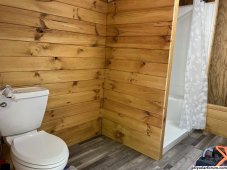We are getting a small cabin for our property in southern Ohio, 640 sq ft. It is completely off grid. End goal is to wire it like a standard 120v home type system but supplied off grid via solar. For the initial time period, I just need something to be able to run a few lights, maybe a fan. A refrigerator will sometime in the relatively near future. Add capability over time as we finish the interior of the cabin. I have a lot of questions, many of which I don't even know what the question is yet. 
Usage is 2-4 days per visit 2 or 3 times a month with an occasional longer stay. Everything will be turned off when we aren't there. That may or may not change once we have solar.
Plan A is to get an EG4 or Trophy 48V 100ah server rack battery and an EG4 3kw all in one. I think 3kw will be sufficient for our needs into the future, but if not it looks easy to add more capacity as needed. We don't need much to run a fridge, a little bit of microwave, or 5 minutes of hairdryer. When I do a power survey using the form in the FAQ, it appears the majority of our needs are running the inverter and running a fridge.
Eventually (3-15 months) we will install solar panels, but I have 1001 projects to get done there and I am hoping to backburner the panel install for a while. My main question for today is how feasible is it to run those components and charge the battery solely with a generator as needed? Seems like you could put a lot of charge in the battery in a couple hours of generator usage. ??? Do the batteries care about what state of charge they are at? Do they need to get to 100% when charged?
Then a question about these all in ones, how much power do they consume when you are actually running something? They publish standby ratings, but seem vague on how to actually get that number and how much they use when you are using power. So if the fridge wants 500 watts, how much does the battery see flowing out? 600 ish?
It's a clean slate, so I am open to any better ideas that get me to the same end point. Budget isn't governmental, but I can spend a few bucks on it.
Usage is 2-4 days per visit 2 or 3 times a month with an occasional longer stay. Everything will be turned off when we aren't there. That may or may not change once we have solar.
Plan A is to get an EG4 or Trophy 48V 100ah server rack battery and an EG4 3kw all in one. I think 3kw will be sufficient for our needs into the future, but if not it looks easy to add more capacity as needed. We don't need much to run a fridge, a little bit of microwave, or 5 minutes of hairdryer. When I do a power survey using the form in the FAQ, it appears the majority of our needs are running the inverter and running a fridge.
Eventually (3-15 months) we will install solar panels, but I have 1001 projects to get done there and I am hoping to backburner the panel install for a while. My main question for today is how feasible is it to run those components and charge the battery solely with a generator as needed? Seems like you could put a lot of charge in the battery in a couple hours of generator usage. ??? Do the batteries care about what state of charge they are at? Do they need to get to 100% when charged?
Then a question about these all in ones, how much power do they consume when you are actually running something? They publish standby ratings, but seem vague on how to actually get that number and how much they use when you are using power. So if the fridge wants 500 watts, how much does the battery see flowing out? 600 ish?
It's a clean slate, so I am open to any better ideas that get me to the same end point. Budget isn't governmental, but I can spend a few bucks on it.






